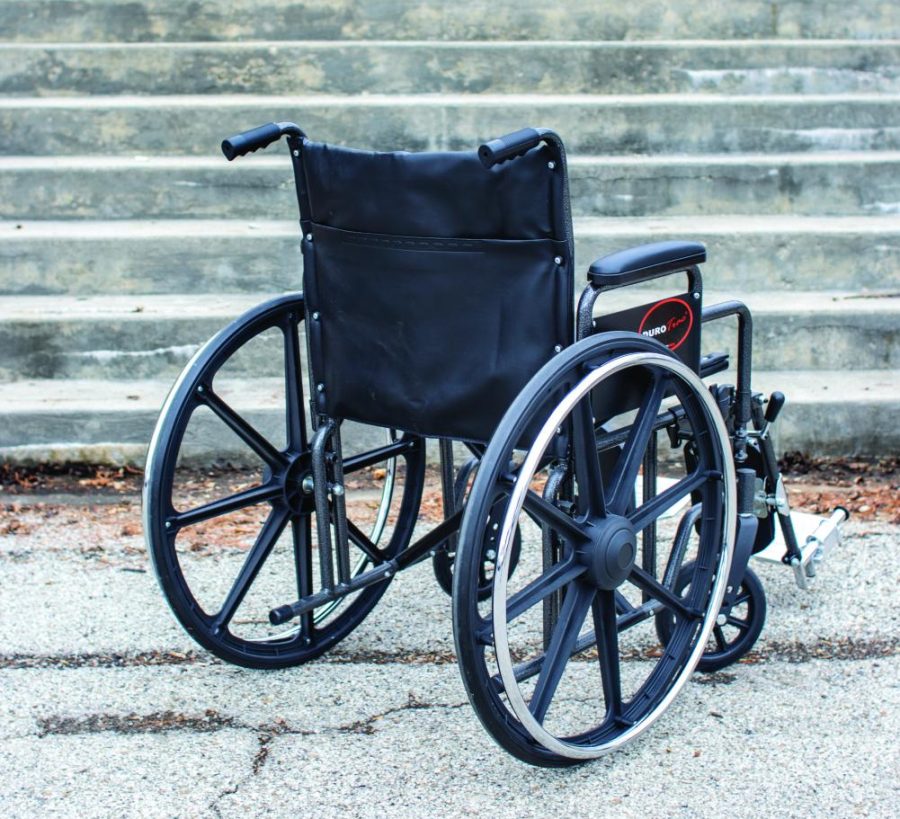EDITORIAL: Students with disabilities should not have to fend for themselves
A wheelchair in front of a flight of stairs outside of Lantz Arena on Nov. 18 at Eastern.
November 30, 2022
Over the past several weeks, we at The News have been looking into the process for reporting issues with accessibility on campus.
We knew it would be a complex issue, but we were not prepared for the extent of the problems we would find.
We did not start this venture with the intentions of “exposing” the university or causing trouble for any offices, much less any individuals on campus. We were just curious and concerned.
The News includes a full staff of competent student journalists who devoted hours of their time to understanding this process, and we still struggled to figure it out.
Many students do not have the time or the number of eyes to look into this.
We never found an official system; whether that’s because of outdated web pages, unwillingness to speak to the media or an actual lack of structure is hard to say.
Students told us about their negative experiences navigating campus and trying to get help from the office of Student Disability Services. Multiple of them thanked us just for listening to their stories.
Why has inaccessibility grown into such a problem at Eastern? Why are students with disabilities such an afterthought? Why do they feel no one is listening to them?
From our observations, only four buildings on campus are entirely accessible.
It’s not that most of the other buildings are completely impossible for people to navigate with mobility aids- small repairs and a little more attention paid to these issues could easily bring them up to par.
It isn’t that we’re expecting the university to drop millions of dollars on a huge overhaul of campus; especially with our historical buildings, we don’t expect massive changes.
As an editorial board, our conversations on this topic kept returning to the fact that this is a compilation of many small issues. The only reason we are seeing a larger problem is a long pattern of complacency.
We have no reason to think that employees at Eastern are intentionally making life more difficult for students with disabilities, but without established ways to handle concerns about accessibility, students struggle to advocate for themselves.
Accessibility is not something you can ignore or compromise on.
It is not a challenge to overcome.
Making the campus accessible should be a part of any university’s typical processes, just like safety checks or inclusivity trainings.
Until solutions are offered, it is not just current students that Eastern will need to answer to. It is also losing out on an entire population of students who may want to attend this university.
Students with disabilities should not have to choose their school based on whether they will be able to get around the campus.
Students should not be expected to go to more expensive universities for accessibility.
Students with disabilities will be attending Eastern until the university shuts down. The number of students with disabilities attending Eastern or even considering Eastern as their ideal university is up to the administration.
For the students with disabilities who do attend Eastern, it is up to administration to decide whether they will have fond memories and stories to tell or whether their memories of college will be about the unnecessary challenges they had to overcome.
The Editorial Staff can be reached at 581-2812.

















![[Thumbnail Edition] Senior Foward Macy McGlone, getsw the ball and gets the point during the first half of the game aginst Western Illinois University,, Eastern Illinois University Lost to Western Illinois University Thursday March 6 20205, 78-75 EIU lost making it the end of their season](https://www.dailyeasternnews.com/wp-content/uploads/2025/03/WBB_OVC_03_O-1-e1743361637111-1200x614.jpg)





















































